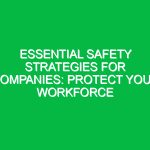Introduction
In the realm of Health, Safety, and Environment (HSE), understanding Safety Hazards examples is fundamental for professionals tasked with ensuring the well-being of employees and the integrity of the environment. Safety Hazards are potential sources of harm or adverse Effects on individuals and the environment, and knowing how to identify and manage these hazards is crucial for creating secure workplaces. This article delves into critical Safety hazards examples that every HSE professional must be aware of, offering insights into their implications, management strategies, and real-world relevance.
Understanding Safety Hazards
Safety hazards can be broadly categorized into several types, each presenting unique challenges and risks. These hazards may arise from various sources, including workplace conditions, operations, and the use of equipment. Recognizing these hazards is the first step in mitigating their potential impact.
When we talk about safety hazards examples, we’re referring to incidents or conditions that could potentially lead to accidents, injuries, or environmental damage. The relevance of these hazards in the HSE context cannot be overstated. A comprehensive understanding of safety hazards equips professionals with the tools they need to implement effective safety protocols, thereby promoting a culture of safety within organizations.
Key Safety Hazards Examples
1. Chemical Hazards
One of the most prevalent safety hazards examples in various industries involves chemical exposure. Chemicals can be found in manufacturing, cleaning, and laboratory environments, posing risks such as toxicity, flammability, and reactivity.
- Example: A laboratory technician working with volatile solvents may face inhalation risks or skin contact that could lead to Burns or respiratory issues.
- Management Strategy: Implementing Material Safety Data Sheets (MSDS) and proper storage protocols can mitigate the risks associated with chemical hazards.
2. Physical Hazards
Physical hazards are another critical category. These hazards arise from environmental factors that can cause harm without direct contact. Examples include noise, radiation, and extreme temperatures.
- Example: Workers in a manufacturing plant might experience hearing loss due to prolonged exposure to high noise levels.
- Management Strategy: Utilizing hearing protection devices and implementing engineering controls, such as sound barriers, can help reduce these risks.
3. Ergonomic Hazards
Ergonomic hazards refer to workplace conditions that can lead to musculoskeletal disorders (MSDs). These hazards often result from repetitive tasks, awkward postures, and heavy lifting.
- Example: A warehouse worker who lifts heavy boxes without proper lifting techniques can suffer from back injuries.
- Management Strategy: Training employees on safe lifting practices and redesigning workspaces to encourage ergonomic movements can significantly reduce these risks.
4. Biological Hazards
Biological hazards encompass a range of pathogens and microorganisms that can cause health issues. This category is particularly relevant in healthcare settings, laboratories, and environments where employees handle food products.
- Example: Healthcare workers may be exposed to bloodborne pathogens, increasing their risk of diseases such as hepatitis or HIV.
- Management Strategy: Implementing strict hygiene practices and providing Personal Protective Equipment (PPE) are essential in mitigating biological hazards.
5. Electrical Hazards
Electrical hazards are common in many workplaces, especially those involving machinery and electrical installations. These hazards can lead to shock, burns, or even electrocution.
- Example: An electrician working on live wires without proper Safety Measures may suffer severe injuries.
- Management Strategy: Adhering to Electrical Safety standards and ensuring regular Maintenance of electrical systems can help prevent these incidents.
Potential Risks and Considerations
Understanding safety hazards examples is not just about identifying them; it also involves recognizing the risks associated with each hazard. Each hazard has the potential to cause severe accidents or long-term health effects.
For instance, consider the case of a construction site where workers are exposed to falling objects. The risk here is not only the immediate physical injury but also the potential for fatal accidents if safety protocols are not in place. HSE professionals must conduct thorough risk assessments to understand the possible consequences of each hazard.
Real-Life Case Studies
To emphasize the importance of recognizing safety hazards examples, let’s explore a few real-life incidents.
Case Study 1: The Chemical Spill
In 2018, a chemical manufacturing plant experienced a significant spill of hydrochloric acid. The incident occurred due to improper labeling and storage. Employees were not adequately trained to handle such materials, leading to several injuries and environmental contamination. The aftermath revealed the importance of proper chemical hazard management, highlighting the need for thorough Training, clear labeling, and emergency response plans.
Case Study 2: The Ergonomic Issue
A retail warehouse faced numerous complaints from workers about back pain and repetitive stress injuries. After an internal investigation and ergonomic assessment, it was discovered that the shelving units were too high, forcing workers to reach excessively. By redesigning the storage layout and providing ergonomic tools, the company reduced injuries significantly and improved employee morale.
Best Practices for Identifying and Managing Safety Hazards
To effectively manage safety hazards examples, HSE professionals can adopt several Best Practices:
- Regular Training: Continuous education on safety protocols is essential for all employees.
- Risk Assessments: Conducting regular assessments helps in identifying potential hazards before they lead to incidents.
- Incident Reporting: Establishing a clear reporting system encourages employees to report hazards or near misses.
- Safety Audits: Regular audits ensure compliance with safety Standards and identify areas for improvement.
Regulations and Standards
HSE professionals must be aware of the Regulations and standards that govern safety hazards examples. These laws serve to guide organizations in implementing necessary Safety Measures.
- Occupational Safety and Health Administration (OSHA): osha sets and enforces standards to ensure safe working conditions.
- Environmental Protection Agency (EPA): The EPA governs Environmental Safety and compliance to minimize harm to the environment.
- National Institute for Occupational Safety and Health (NIOSH): NIOSH conducts research and makes recommendations for the Prevention of work-related injuries and illnesses.
Compliance with these regulations is not just a legal requirement; it is a vital component of an organization’s commitment to safety. Failure to comply can lead to severe penalties, including fines and shutdowns, as well as damage to a company’s reputation.
Conclusion
In summary, understanding safety hazards examples is crucial for every HSE professional. From chemical and physical hazards to ergonomic and biological risks, each category presents unique challenges that require diligent management and proactive strategies. By implementing Best Practices, adhering to regulations, and learning from real-life incidents, HSE professionals can foster safer workplaces and contribute to overall health and environmental Sustainability.
In the ever-evolving landscape of Workplace Safety, continuous education and vigilance are key. As the world changes, so do the hazards. Staying informed and prepared is not just beneficial; it’s essential for protecting workers and the environment alike. Therefore, let this be a call to action for all HSE professionals to prioritize safety awareness and proactive hazard management in their daily operations.


